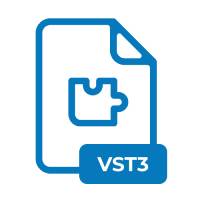.VST3 File Extension

VST 3 Audio Plug-in
| Developer | Steinberg |
| Popularity | |
| Category | Plugin Files |
| Format | .VST3 |
| Cross Platform | Update Soon |
What is an VST3 file?
.VST3 files are associated with VST3 (Virtual Studio Technology 3), an audio plug-in format developed by Steinberg as the successor to the VST2 format.
These files serve as audio plug-ins used to integrate advanced audio effects, instruments, and processing tools into digital audio workstations (DAWs) and other audio software.
More Information.
Steinberg’s VST3 technology builds upon the legacy of the VST2 format, incorporating advancements in audio processing, user interface design, and compatibility with modern operating systems and hardware architectures.
The introduction of .VST3 plug-ins marked a significant milestone in the evolution of audio plug-in technology, offering developers and users a more powerful and versatile platform for audio production, mixing, and mastering.
Origin Of This File.
The .VST3 file format was introduced by Steinberg in response to the evolving needs and requirements of the audio industry, aiming to provide a more efficient, flexible, and feature-rich platform for audio plug-ins compared to the older VST2 format.
This standardized format offers improved performance, stability, and functionality for audio production and processing tasks.
File Structure Technical Specification.
.VST3 files are distributed as binary files containing compiled code, resources, and metadata required to implement the audio plug-in’s functionality.
While the exact structure and contents of .VST3 files may vary depending on the plug-in’s complexity and features, common components include:
- Executable Code: Binary code containing the plug-in’s audio processing algorithms, user interface elements, and other functionality.
- Resources: Audio samples, presets, graphics, and other assets used by the plug-in for its user interface, sound generation, or processing tasks.
- Metadata: Information about the plug-in, such as its name, version, author, description, and compatibility with different DAWs and operating systems.
How to Convert the File?
Converting .VST3 files are generally not necessary, as they are specifically designed for use with audio software that supports the VST3 plug-in interface.
Users may need to install or update .VST3 plug-ins to ensure compatibility with their DAWs or operating systems. Conversion methods can vary depending on the specific requirements and tools available. Common approaches include:
- Installation: Download and install .VST3 plug-ins from reputable sources or authorized distributors, following the installation instructions provided by the plug-in manufacturer.
- Update: Check for updates or newer versions of .VST3 plug-ins to ensure compatibility with the latest versions of your DAW and operating system, and follow the update instructions provided by the plug-in manufacturer.
Advantages And Disadvantages.
Advantages:
- Enhanced Performance: VST3 plug-ins offer improved performance and efficiency compared to VST2 plug-ins, thanks to optimizations such as multi-threaded processing, sample-accurate automation, and reduced CPU overhead.
- Advanced Features: VST3 introduces new features and capabilities for audio plug-ins, such as dynamic parameter automation, scalable user interfaces, and improved MIDI integration, enabling developers to create more sophisticated and interactive plug-ins.
- Platform Compatibility: VST3 plug-ins are designed to be cross-platform compatible, allowing them to run seamlessly on different operating systems and hardware configurations without sacrificing performance or stability.
Disadvantages:
- Transition Challenges: The transition from VST2 to VST3 may present challenges for users and developers, such as compatibility issues with existing plug-ins, migration of projects and presets, and learning curve for new features and workflows.
- Limited Adoption: While VST3 has been adopted by many audio software developers and manufacturers, some users and DAWs may still rely on VST2 plug-ins due to compatibility concerns or preference for familiar tools and workflows.
- Resource Intensiveness: Certain VST3 plug-ins may consume significant CPU and memory resources, particularly if they implement complex audio processing algorithms or high-resolution graphical user interfaces.
How to Open VST3?
Open In Windows
- Download and install a digital audio workstation (DAW) or audio editing software that supports VST3 plug-ins, such as Ableton Live, FL Studio, or Reaper.
- Launch the DAW or audio software and navigate to the plug-in management or preferences menu.
- Scan for VST3 plug-ins and select the location where your .VST3 files are located to add them to the plug-in library.
- The .VST3 plug-ins will now be available for use within your DAW or audio software.
Open In Linux
- Many Linux audio software applications, such as Ardour, Audacity, or Carla, support VST3 plug-ins through compatibility layers like Wine or LinVst.
- Install Wine or LinVst on your Linux system and configure it to support VST3 plug-ins.
- Follow the same steps as in Windows to add .VST3 plug-ins to your Linux audio software.
Open In MAC
- macOS supports VST3 plug-ins natively in some audio software applications like Logic Pro X or GarageBand.
- Follow the same steps as in Windows to add .VST3 plug-ins to your macOS audio software.













